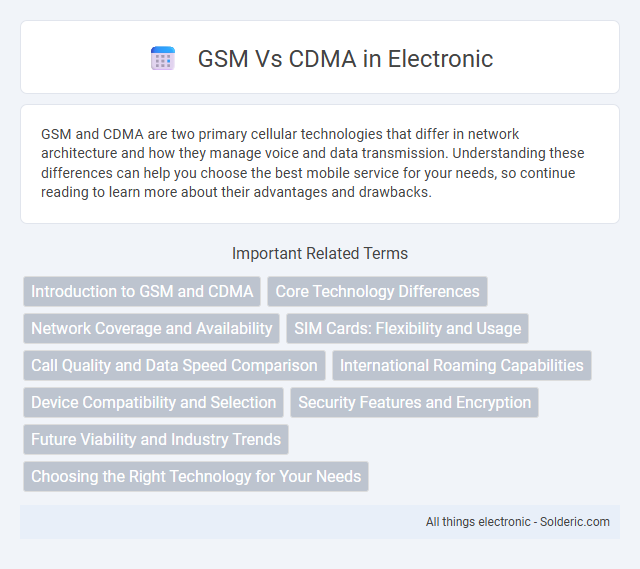GSM and CDMA are two primary cellular technologies that differ in network architecture and how they manage voice and data transmission. Understanding these differences can help you choose the best mobile service for your needs, so continue reading to learn more about their advantages and drawbacks.
Comparison Table
| Feature | GSM (Global System for Mobile Communications) | CDMA (Code Division Multiple Access) |
|---|---|---|
| Technology | Time Division Multiple Access (TDMA) based | Code Division Multiple Access |
| SIM Card | Uses SIM card for subscriber identity | No SIM card traditionally; embedded in device |
| Network Coverage | Widely used globally, especially in Europe and Asia | Primarily used in the USA and some parts of Asia |
| Frequency Bands | Operates on multiple frequency bands (850, 900, 1800, 1900 MHz) | Operates mainly on 850 and 1900 MHz bands |
| Data Transmission | Supports GPRS, EDGE, 3G, LTE | Supports EVDO, 3G, LTE |
| Call Quality | Good call quality, depends on signal strength | Generally better call quality with less dropped calls |
| Device Compatibility | Wide range of compatible devices due to SIM | Devices locked to specific carriers |
| Roaming | Easier international roaming | Limited international roaming |
| Security | Uses SIM-based authentication | Uses spread spectrum technology, harder to intercept |
Introduction to GSM and CDMA
GSM (Global System for Mobile Communications) and CDMA (Code Division Multiple Access) are two predominant cellular network technologies that define how mobile devices connect and communicate. GSM relies on time division multiple access to allocate unique time slots for each user, widely used in Europe and Asia, while CDMA employs spread-spectrum technology allowing multiple users to share the same frequency band, common in North America. Understanding the distinctions in network architecture and frequency usage helps you select compatible devices and optimize your mobile connectivity experience.
Core Technology Differences
GSM (Global System for Mobile Communications) uses time-division multiple access (TDMA) to allocate separate time slots for multiple users, while CDMA (Code Division Multiple Access) employs spread-spectrum technology to assign unique codes to each call, allowing simultaneous transmission over the same frequency band. GSM relies on SIM cards to authenticate users and supports international roaming more effectively, whereas CDMA integrates subscriber information into the device itself, making SIM swapping less common. Understanding these core technology differences helps you choose a network that aligns with your device compatibility and coverage needs.
Network Coverage and Availability
GSM networks generally offer broader global coverage and better availability due to widespread adoption across over 210 countries, making it ideal for international travelers. CDMA networks, while providing reliable service in specific regions like the United States and parts of Asia, have more limited global reach and fewer carrier options. You should consider GSM for better network compatibility and coverage when traveling internationally.
SIM Cards: Flexibility and Usage
GSM technology utilizes SIM cards that store subscriber information, enabling easy switching between devices and networks by simply transferring the SIM card. CDMA networks generally do not use SIM cards for subscriber identification, resulting in less flexibility when changing phones or carriers. This fundamental difference makes GSM preferable for users seeking greater device portability and international roaming capabilities.
Call Quality and Data Speed Comparison
GSM networks typically offer more consistent call quality due to their widespread global use and support for simultaneous voice and data transmission via technologies like GPRS and EDGE. CDMA networks often provide better call clarity and reduced drop rates in areas with strong signal strength, using techniques like power control and interference management. Data speed on GSM has improved significantly with 3G UMTS and 4G LTE networks, but CDMA networks, especially those upgraded to EV-DO and 4G LTE, can achieve comparable or superior data throughput depending on carrier infrastructure and spectrum allocation.
International Roaming Capabilities
GSM technology offers superior international roaming capabilities due to its widespread adoption in over 200 countries and compatibility with most global networks. CDMA networks have limited international roaming options because they rely on fewer carriers and proprietary technology, restricting usage primarily to regions like the United States and parts of Asia. GSM's use of SIM cards also facilitates easy device switching and seamless connectivity when traveling abroad, enhancing user convenience.
Device Compatibility and Selection
GSM technology supports a wide range of devices due to its use of SIM cards, enabling easy switching between compatible phones and networks worldwide. CDMA devices are often locked to specific carriers, limiting compatibility and making device selection more restrictive. Choosing between GSM and CDMA impacts handset availability, network flexibility, and international roaming capabilities.
Security Features and Encryption
GSM uses A5/1 and A5/3 encryption algorithms to secure voice and data transmissions, providing robust protection against eavesdropping. CDMA employs a spread-spectrum technique combined with encryption algorithms like CAVE and AES, offering enhanced resistance to interception and fraud. Your choice between GSM and CDMA can impact the level of security and encryption resilience available to your mobile communications.
Future Viability and Industry Trends
GSM technology continues to dominate globally due to its wide adoption and compatibility with advanced 4G and 5G networks, ensuring strong future viability. CDMA, while still used in certain regions, is gradually being phased out as carriers transition to more efficient and globally standardized LTE and 5G technologies. Your device choices should consider GSM's broader network support and ongoing industry investment for sustained connectivity.
Choosing the Right Technology for Your Needs
Choosing between GSM and CDMA depends on your coverage priorities and device compatibility. GSM offers wider international roaming and supports SIM cards, allowing easy switching between devices. CDMA may provide better call quality and coverage in specific regions, so evaluate your location and travel habits to select the best technology for your needs.
GSM vs CDMA Infographic

 solderic.com
solderic.com